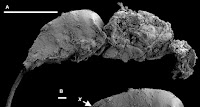Pemphredonines are
small Apoid Wasps (the group of Wasps from which Bees are thought to have arisen) found across the globe, but particularly
diverse in the Australasian region. They are solitary predatory Wasps, the females of which nests in burrows or in plants, and stock these with multiple, paralized but living prey, which the larvae consume upon emerging from their eggs. Pemphredonine Wasps
target a variety of prey, including Auchenorrhyncha (Cicadas, Leafhoppers etc.),
Sternorrhyncha (Aphids, Scale Insects etc.), Thysanoptera (Thrips) and Collembola
(Springtails), with each species of Wasp tending to focus on a particular prey species.
In a paper published in
the journal Paleontological Contributions on 1 December 2014, Daniel
Bennett of the Department of Biology at Stephen F. Austin State University, Vincent Perrichot of Géosciences at Observatoire desSciences de l’Univers de Rennes and the Division of Entomology (Paleoentomology) at the University of Kansas Biodiversity Institute
and Michael Engel of the Division of Entomology (Paleoentomology) at
the University of Kansas Biodiversity Institute and the Department ofEcology & Evolutionary Biology at the University of Kansas,
describe a new species of Pemphredonine Wasp from the Late Cretaceous
of Vendée Department in northwest France.
The species is described
from a single specimen preserved in a piece of clear orange amber,
dated to between 85 and 97 million years old (Late Cretaceous),
though the site where it was collected was only briefly exposed
during road works on the D32 between La Garnache and Challans.
It is named Menopsila
dupeae, where ‘Menopsila’ is an anogram of three
modern groups of Pemphredonine Wasps, the Spilomena, Psilomena, and
Lisponema, and ‘dupeae’ honours Fanny Dupé, who collected
the specimen and other insects in amber from the site, and allowed
Bennett et al. to study them. The specimen is male and 1.85 mm
in length. It shows a mixture of traits associated with different
modern groups of Pemphredonine Wasps and cannot be comfortably placed
in any of them; the origins of the group are not well understood at
this time due to a limited number of well preserved specimens.
Head and pronotum of
Menopsila dupeae in frontolateral view. Bennett
et al. (2015).
See also...
 A Chalcid Wasp from the Early Cretaceous of Brazil. Chalcid Wasps are among the most widespread and numerous of all Insects,
with over 22 000...
A Chalcid Wasp from the Early Cretaceous of Brazil. Chalcid Wasps are among the most widespread and numerous of all Insects,
with over 22 000... Four new species of Wasp from Cretaceous amber. Diaprioid Wasps are small parasitoids (i.e. their larvae grow inside the
bodies of other animals) that...
Four new species of Wasp from Cretaceous amber. Diaprioid Wasps are small parasitoids (i.e. their larvae grow inside the
bodies of other animals) that...
 An early Woodwasp from the Early Cretaceous of Brazil. The Hymenoptera are one of the largest groups of insects, comprising
Sawflies, Wasps, Ants and Bees. The earliest members of the group were
Sawflies, which appeared around the beginning of the Late Triassic.
Sawflies have caterpillar-like...
An early Woodwasp from the Early Cretaceous of Brazil. The Hymenoptera are one of the largest groups of insects, comprising
Sawflies, Wasps, Ants and Bees. The earliest members of the group were
Sawflies, which appeared around the beginning of the Late Triassic.
Sawflies have caterpillar-like...
Follow Sciency Thoughts on Facebook.

